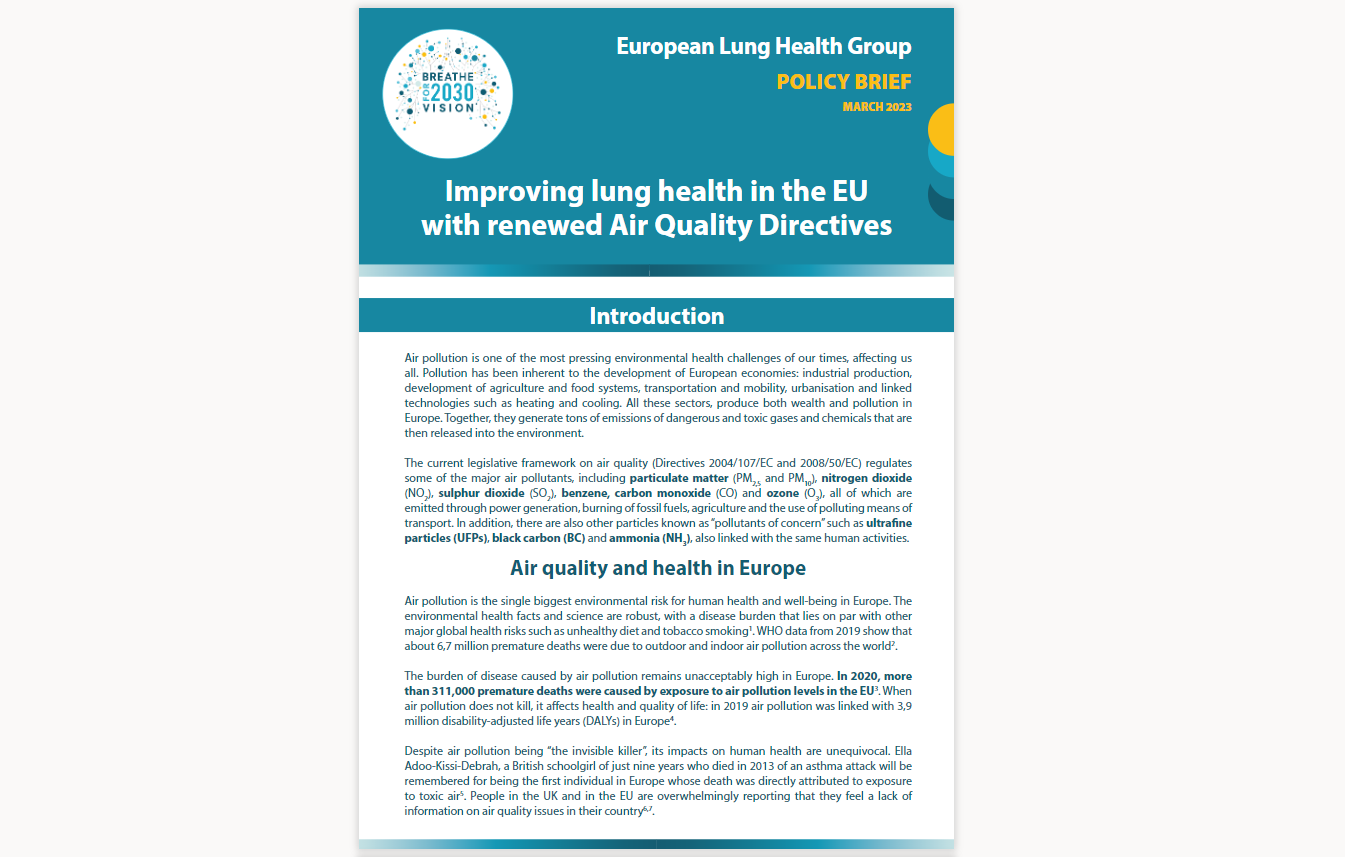
Brussels, 28 March 2023 – Today the European Lung Health Group launched its policy brief ‘Improving lung health in the EU with renewed Air Quality Directives’. The document outlines the call of the European respiratory community to ensure the future EU Air Quality Directive sets stricter air quality standards that increase the protection of lung health
1. Air pollution imposes an unacceptable toll in Europe, killing more than 311,000 people annually and leading to welfare loss and an increase in social inequalities2 3 4. The lungs are severely affected by dirty air 5. Robust scientific evidence associates exposure to air pollution with the onset or exacerbation of fatal respiratory diseases. Prenatal and early-life exposure also leads to reduced lung function and respiratory disease later in life6 7 8.
The European Lung Health Group calls on the European Parliament and the Council to ensure that health is the key factor when negotiating the EU Air Quality Directives proposed by the European Commission. In view of the crucial debates and negotiations that are upcoming at the European Parliament and the Council level, we call on the EU institutions to show leadership, translate science into policy, and bring all the benefits of cleaner air to European citizens.
Organisations representing patients and healthcare professionals who are part of the ELHG recommend policy options to improve lung health indicators, provide tools for citizens to reduce their exposure to air pollution, and increase accountability on polluters of the health damage they cause.
The European Lung Health Group urgently calls to:
1. Promote a high level of public health protection through the full alignment of EU air quality standards with the 2021 WHO Air Quality Guidelines by no later than 2030.
2. Ensure a future-proof air quality framework, via a mechanism that will enable the review of future scientific evidence of health impacts due to air pollution and allow for fast update of the air quality standards, including expansion to pollutants currently not covered.
3. Improve the air pollution monitoring network and scope, with a stronger focus on health effects and supporting citizen-driven monitoring.
4. Put citizens at the centre of the directives, enabling easy access to justice, timely compensation for health damages due to air pollution, strict penalties for polluters and quick litigation procedures.
5. Facilitate access to real-time public information on air quality, including a harmonisation of national Air Quality Indices (AQIs) and the adoption of information thresholds for all pollutants.
You can find the full policy briefing here.
ENDS
Notes to editors
The European Lung Health Group brings together nine European level organisations representing 179 non-profit patients and healthcare professionals organisations in 34 countries.
1 Proposal for a Directive of the European Parliament and of the Council on ambient air quality and cleaner air for Europe (recast), October 2022. The proposal merges two pre-existing directives, namely 2008/50/EC on ambient air quality and cleaner air for Europe; and 2004/107/EC relating to arsenic, cadmium, mercury, nickel and polycyclic aromatic hydrocarbons in ambient air into one consolidated Directive, https://eur-lex.europa.eu/legal-content/EN/TXT/?uri=COM%3A2022%3A542%3AFIN
2 European Environment Agency, ‘Premature deaths due to air pollution continue to fall in the EU, more efforts needed to deliver a toxic-free environment’, November 2022, https://www.eea.europa.eu/highlights/premature-deaths-due-to-air
3 Organisation for Economic Co-operation and Development (OECD), Health at a Glance: Europe 2020: State of Health in the EU Cycle, December 2020, https://tinyurl.com/bdf26pt2
4 European Environment Agency (EEA), ‘Unequal exposure and unequal impacts: social vulnerability to air pollution, noise and extreme temperatures in Europe’, February 2019, https://www.eea.europa.eu/publications/unequal-exposure-and-unequal-impacts
5 The spectrum of respiratory disease affects about 240 million patients in Europe who live with infectious diseases (such as tuberculosis) and non-communicable diseases (such as allergies, asthma, chronic obstructive pulmonary disease (COPD), bronchiectasis and lung cancer) to those classified as rare and ultra rare (alpha-1, idiopathic pulmonary fibrosis and pulmonary hypertension).
6 T. To, J. Zhu et al., ‘Early life exposure to air pollution and incidence of childhood asthma, allergic rhinitis and eczema’, European Respiratory Journal, February 2020, https://erj.ersjournals.com/content/55/2/1900913
7 L. Agier, X Basagaña et al., ‘Early-life exposome and lung function in children in Europe: an analysis of data from the longitudinal, population-based HELIX cohort’, February 2019, https://www.thelancet.com/journals/lanplh/article/PIIS2542-5196(19)30010-5/fulltext
8 A. Bettiol, E. Gelain et al., ‘The first 1000 days of life: traffic-related air pollution and development of wheezing and asthma in childhood. A systematic review of birth cohort studies’, Environmental Health, April 2021, https://ehjournal.biomedcentral.com/articles/10.1186/s12940-021-00728-9
For more information contact
Zorana Jovanovic Andersen
Chair of the European Respiratory Society Environment and Health Committee
Professor in Environmental Epidemiology, Department of Public Health, University of Copenhagen
vlq961@sund.ku.dk
Panagiotis Chaslaridis
EFA Senior Policy Advisor
panagiotis.chaslaridis@efanet.org +32 (0) 2 227 2720